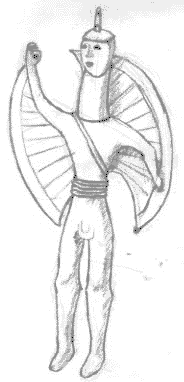When some major sanctuaries, such as Delphi, Olympia and Dodona, and some of local importance were established, bronze cauldrons with attachments of human or animal figures were dedicated.The technique is same as Bronze age and there's no large statuette. These human and animal figurines are highly stylized, which recall the representation on contemporary vase-painting. The human figurine has the broad shoulder, constricted waist and plump legs. Other than these attachments, free-standing bronze figurines were manufactured in the late 8th century B.C. Most were a found from sanctuaries, probably portrayed deities or heroes. A warrior from Thessaly, dated about 700 B.C., bears resemblance to the figures on painted pottery, except for the long neck (Athens12831:Fig.1). He wears helmet, belt and shield of Boeotian type and the spear once in his right hand is missing. The style of animal figurines, slim limb and body, also closes to the representation on contemporary vase-painting. There are some groups, a fawn at the mothers breast demonstrates the technique of bronze casting was developed (Boston98.650). Concentric circles on the body reappeared on some animal figures of pedimental sculptures of 6th century B.C. Bibliography |
